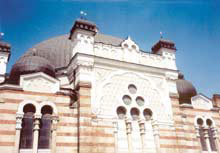Jewish organizations still influence today

The Sofia synagogue, situated in the heart of the capital city, is the third largest in Europe and known as one of the most beautiful architectural monuments in Bulgaria.
In the capital of Bulgaria, Sofia, is situated the biggest open-air bookstore on the Balkans. Walking between the aisles, however, I noticed a considerable amount of anti-Semitic literature. The Jewish School in Sofia and the synagogue were “decorated” with swastikas. Even the walls in the building where I lived were scratched with black fylfots.
Mein Kampf’s price is around 25lv ($12), which is pretty expensive for Bulgaria. This fact, however, doesn’t make it less desirable. The Bulgarian society seeks the reason for this recent interest toward anti-Semitic literature. I decided to ask the sellers in the bookstore what kind of people read anti-Semitic literature.
They replied some buy it out of simple curiosity because during communism all kinds of fascist literature was forbidden by the constitution. Others want to possess it because it is fashionable lately to have erratic and scandalous ideas. Skinheads’ gangs also appeared in Sofia. Most of the members, however, are teen-agers from poor families, who seek somebody responsible for their fate. It even turned out that the boy who made the swastikas in the building I lived in was 14 years old, and a couple of weeks later his grandmother made him clean the walls.
Shalom is the name of the biggest and most influential Jewish organization in Bulgaria. It is the biggest in the struggle against the fascist literature in Bulgaria. Shalom insists these types of books should not be published at all. The Jewish Cultural House in Sofia is the headquarters of the organization. It functions as an informational center, library, cafeteria, food for the poor and rehabilitation center for adults. Shalom also publishes the Jewish newspaper, Evreiski vest (Jewish News).
More evidence of the Jewish community’s stability is the so-called Jewish School in Sofia, which is on its way to becoming a high school. It is considered one of the best schools in Sofia thanks to its financial aid from Israel and the United States and to its qualified teachers and special study curriculum. Three hundred students attend the school; half of them are non-Jewish Bulgarians.
The synagogue in Sofia is situated in the very heart of the Bulgarian capital. It is the third largest in Europe. The synagogue was designed by Austrian architect Grunander in a Spanish-Moresque style. It resembles the Vienna synagogue destroyed by the Nazis. The Sofia synagogue is one of the most beautiful architectural monuments in Bulgaria, and it accommodates 1,300 worshipers. For several years already the synagogue is under restoration, and now the synagogue is shining to its splendor.
In spite of the fact that the Jewish population has been greatly reduced from 50,000 after World War II to 6,000 today, an increasing number of young people now attend the divine services.
On great festive days, such as the European Day of Jewish Culture, hundreds of people gather to celebrate.
This year, for the third time, the European Day of Jewish Culture was celebrated. In Bulgaria it was mainly noted in the larger cities. It aims to show the Jewish culture and traditions.
The European Day of Jewish Culture is a day of open doors.
All synagogues and museums connected with Jewish heritage were opened for visitors. Paintings of famous Bulgarian-Jewish painters were exhibited in the Jewish Cultural House in Sofia. In the Sofia synagogue, there was a concert in Everett, a speech by Edi Shwartz about the Jewish calendar, and typical Jewish dancing.
Your donation will support the student journalists of Missouri Southern State University. Your contribution will allow us to purchase equipment and cover our annual website hosting costs.



























